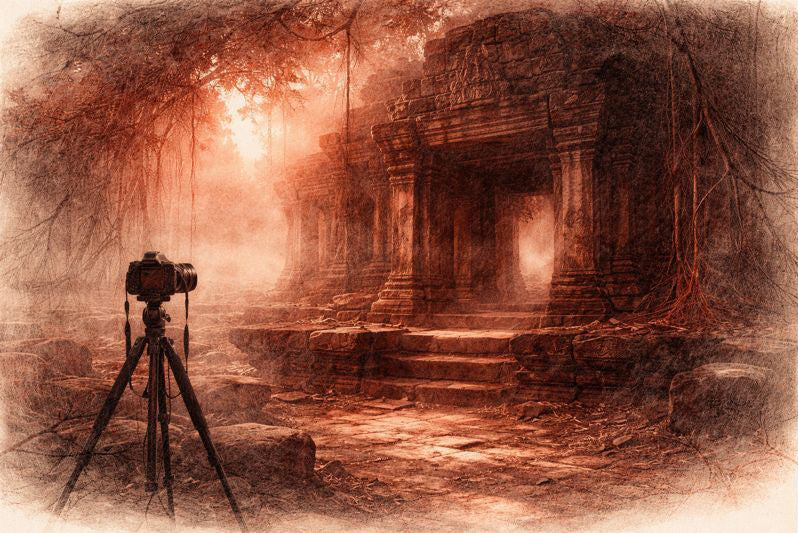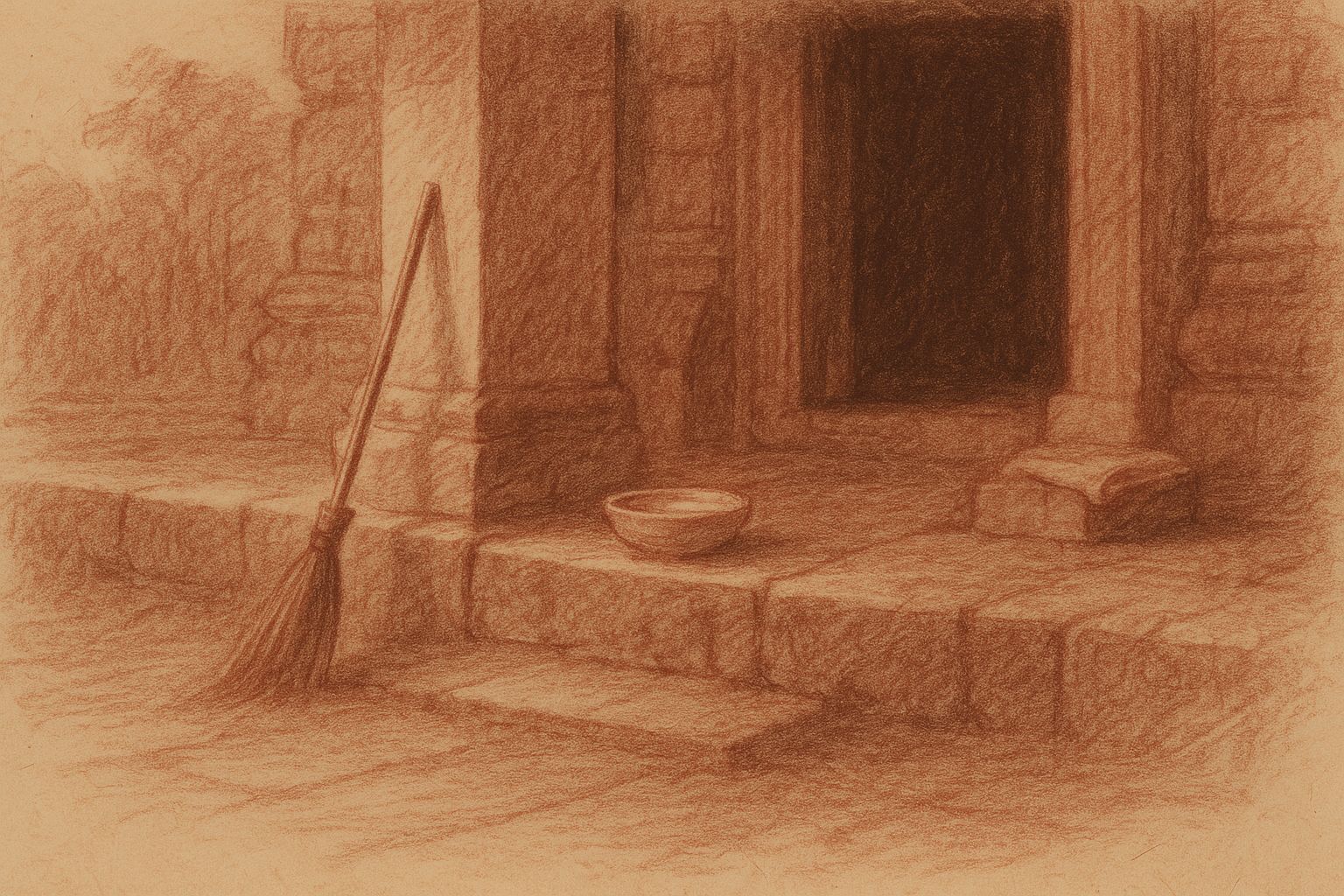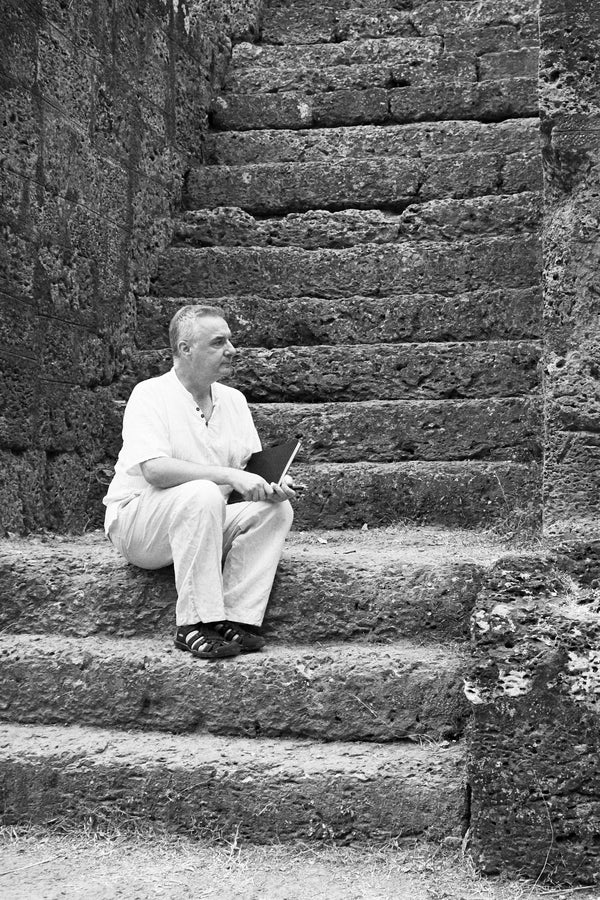Complimentary worldwide shipping on orders over $400 · No import tariffs for most countries
Complimentary worldwide shipping on orders over $400 · No import tariffs for most countries

Krishna Govardhana
Reliefs depicting Krishna lifting Mount Govardhana are remarkably popular in Angkor. Since early pre-Angkorean times they occur in almost every temple, Hindu and Buddhist, carved in large pediments and in small decorative niches.
Krishna (the dark one), the eighth avatar of Vishnu, is known in this episode from the Harivamsa and the Bhagavata Purana as Krishna Govardhanadhara.
The reliefs at Angkor depicting the tale are known as Krishna Govardhana. They show the god lifting the mountain above his head to protect the cowherds and their cattle from the torrential rains caused by Indra's ire. The god held the mountain above ground in one hand for seven days. In the Harivamsa tale he is accompanied by his brother Balarama, who doesn’t always appear in these reliefs. This episode marks the end of Krishna's childhood.
These are narrative reliefs; carvings which depict an event or an action that progresses in time and leads to another event, even if only part of the story is shown, implying a development of the story in time. The reliefs showing Krishna lifting Mount Govardhana display the incident when Krishna lifts the mountain into the air, but it requires the viewer to imagine the preceding event of Indra punishing the cowherds with a thunderstorm, and the ensuing episode when Indra acknowledges Krishna’s superiority and appoints him as ‘Govinda’.
So, to better understand the Krishna Govardhana reliefs, we will begin our telling of this story from the beginning...
The Prevention of the Sacrifice to Indra
While living as a gopa, Krishna noticed some of his fellow cowherds preparing for the Indra-yaga, a ceremony to propitiate rain from Indra. One of the gopa elders informed him that Indra was venerated not only because he could produce water, source of life and delight, but also because he could deliver the promise of righteousness (dharma), prosperity (artha) and love (kama). In reply, Krishna said that only the Supreme God could do this and that Indra did not have the appropriate power. He dissuaded the cowherds from their celebrations and admonished them, saying that their gods were the cows, the mountains, the forests and the verdant hills where they brought their animals to graze.
With the agreement of the cowherds, Krishna requested the ‘sacrifice to the mountain’ for the propitiation of the cows, the Brahman and the sacred mountain, Govardhana. He participated both as a cowherd (a worshipper) and as the being identified with the mountain (the object of worship). At the end of the sacrifice, the mountain had transformed by magic into Krishna himself and he consumed, again by magic, the offerings. Having witnessed this extraordinary event, the jubilant cowherds have worshipped him ever since.

Figure 1. The Prevention of the Sacrifice to Indra, Angkor Wat Temple, Cambodia
You can see a larger version of this image by clicking here. ⧉
Figure 1 shows the depiction of prevention of the sacrifice to Indra as seen at Angkor Wat Temple, in the south-western corner pavilion. Krishna, stands in hieratic attitude, wearing a tall crown and traditional body ornaments. He is represented as Vishnu with four arms, the upper right holding the disc (chakra), the upper left the conch, and his lower hands in the attitude of receiving offerings in pointed containers from worshippers kneeling around him. The worshipper to his left, with a beard and elaborate hairstyle, wears a long vest signifying high rank. The scene takes place in a forest, and celestial beings (gandharvas), wearing crowns and carrying garlands of flowers or jewels fly in the sky.
Krishna Lifting Mount Govardhana
Indra was enraged at being deprived of his worship, and sent a host of terrifying clouds (samvartaka) to bring destruction to Earth and the universe. Torrential rain and showers of hailstones, accompanied by flashes of lightning and the roar of thunderbolts terrified Nanda, the cowherds and their cattle, who sought refuge with Krishna.
Krishna took counter-measures using his yogic power in order to stop Indra’s arrogance and humiliate him. Easily uprooting Mount Govardhana with one hand, he held it above his head for seven days to give protection to the cowherds and their animals from the vehemence of Indra’s storm.

Figure 2. Krishna Lifting Mount Govardhana (detail), Angkor Wat Temple, Cambodia
You can see a larger version of this image by clicking here. ⧉
And the full relief panel by clicking here. ⧉
In Figure 2 we see a panel, again from the south-western corner pavilion of Angkor Wat Temple, depicting the Krishna Govardhana scene set in a pastoral landscape of shepherds and domestic animals, in which Krishna and Balarama stand out from the rest. Despite their rich apparel, they are nevertheless cowherds, as shown by the herdsman’s crook that Krishna holds with his left hand, and which Balarama has on his shoulder. To indicate his youth, Krishna’s hair is arranged around a mukuta surmounted by long braids tied up in three knots from which pointed tufts emerge. Above them, the mountain, conventionally represented by an arrangement of small lozenges, has ascetics sitting cross-legged in the forest, which is also inhabited by wild animals.
It is interesting to note the position of Krishna in most of the other Krishna Govardhana scenes carved at Angkor. His weight is supported on one leg, while the other is crossed in front of it, gently supported by the toes. This is the padasvastica position of Indian iconography, symbolising benevolent tranquillity.
Krishna Govinda
Unlike Rama (of the Ramayana), it was not possible for Krishna to obtain royal status on earth. Krishna was from the Yadava lunar race that had settled in Dwaraka and was descended from Yadu, recipient of a curse preventing his descendants from obtaining effective royal power.
In saving his cows and cowherds, Krishna had revealed his status of avatar. As a result, Indra admitted defeat, acknowledged Krishna’s superiority and appointed him ‘Govinda’, ‘The Protector of Cows’ and Lord of Goloka (kingdom of the cows).

Figure 3. Krishna Govinda, Preah Khan Temple, Angkor, Cambodia
You can see a larger version of this image by clicking here. ⧉
In Figure 3 we see a half pediment in the central section, eastern area, of Preah Khan Temple which can be read as the veneration of Krishna on the part of his goatherds after Indra named him ‘Govinda’.
Krishna then had to continue the mandate of the gods by killing Kamsa and his acolytes Kesin and Arishta to re-establish the rightful kingship of Ugrasena. Finally, he would have to help Arjuna kill the evil kings in the great ‘Battle of Kurukshetra’. But more of those tales later.
Please also see:
- My other Journal articles exploring the Krishna Myths at Angkor
- Images of Krishna Govardhana at Angkor, Cambodia ⧉
- Images of Krishna at Angkor, Cambodia ⧉
If you enjoyed this article, and you would like to continue to share in my adventures, please sign up for my newsletter below. Since I no longer post on social media, this is the best way to stay up-to-date with my work.
Also in Library

Before the Shutter Falls
3 min read
Before the shutter falls, fear sharpens and doubt measures the cost of waiting. In the quiet hours before dawn, the act of not-yet-beginning becomes a discipline of attention. This essay reflects on patience, restraint, and the quiet mercy that arrives when outcome loosens its hold.

Those Who Keep the Way Open — On the Quiet Guardians of Angkor’s Thresholds
3 min read
Quiet gestures shape the way into Angkor — a swept stone, a refilled bowl, a hand steadying a guardian lion. This essay reflects on the unseen custodians whose daily care keeps the thresholds open, revealing how sacredness endures not through stone alone, but through those who tend its meaning.

Multiplicity and Mercy — The Face Towers of Jayavarman VII
5 min read
A new vision of kingship rises at the Bayon: serene faces turned to every horizon, shaping a world where authority is expressed as care. Moving through the terraces, one enters a field of steady, compassionate presence — a landscape where stone, light, and time teach through quiet attention.
Join My Studio Journal
Receive occasional letters from my studio in Siem Reap—offering a glimpse into my creative process, early access to new fine art prints, field notes from the temples of Angkor, exhibition announcements, and reflections on beauty, impermanence, and the spirit of place.
No noise. No clutter. Just quiet inspiration, delivered gently.
Subscribe and stay connected to the unfolding story.

Join My Studio Journal
Receive occasional letters from my studio in Siem Reap—offering a glimpse into my creative process, early access to new fine art prints, field notes from the temples of Angkor, exhibition announcements, and reflections on beauty, impermanence, and the spirit of place.
No noise. No clutter. Just quiet inspiration, delivered gently.
Subscribe and stay connected to the unfolding story.
